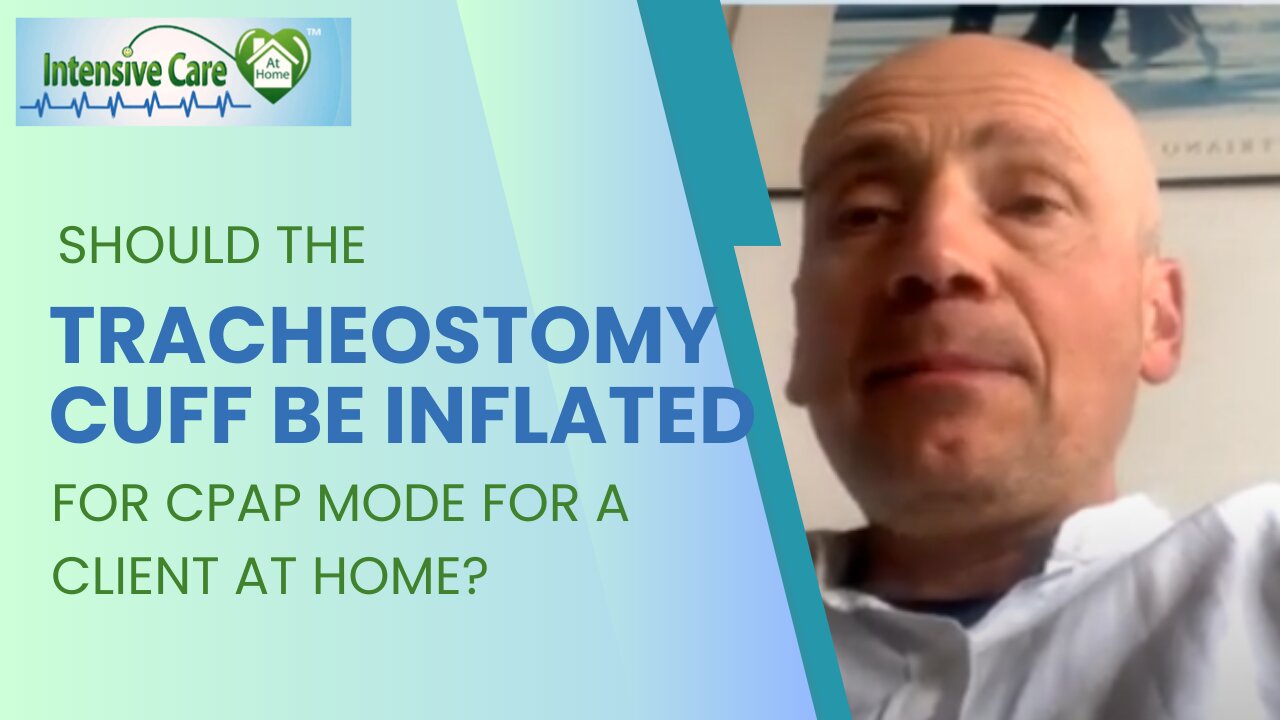Premium Only Content

Should the Tracheostomy Cuff be Inflated for CPAP Mode for a Client at Home?
Should the Tracheostomy Cuff be Inflated for CPAP Mode for a Client at Home?
Here are the phone options
One day 1:1 consulting and advocacy FACE TO FACE or via zoom $20,000 per day
https://intensivecarehotline.thrivecart.com/one-day-11-consulting-in-person-face/
Book your free 15-minute phone consultation here
http://intensivecarehotline.com/scheduling-appointment/
Call directly 24/7
+1 415-915-0090 USA/Canada
+44 118 324 3018 UK
+6141 094 2230 Australia
Email support@intensivecarehotline.com
Get 1:1 consulting and advocacy
1:1 phone counselling
http://intensivecarehotline.com/one-on-one-counselling/
Become a member for families of critically ill Patients in Intensive Care
https://intensivecarehotline.com/intensivecaresupport-org-membership/
Immediate action steps http://intensivecarehotline.com/take-control-take-charge/immediate-action-steps/
https://intensivecareathome.com
And if you need a medical record review, click on the link and we can help you with reviewing your loved one’s medical records while they’re in ICU.
https://intensivecarehotline.thrivecart.com/review-of-medical-records/
Facebook Page: https://www.facebook.com/IntensiveCareHotline
Twitter: https://twitter.com/icuhotline
Song: Jarico - Island Music
supported by@FreeBackgroundMusicForCreators
#BackgroundMusicWithoutLimitations
https://bit.ly/2XoXFnb
Hi, it’s Patrik Hutzel from Intensive Care at Home, where we provide tailor-made solutions for long-term, ventilated adults and children with tracheostomies. And where we also provide tailor-made solutions for hospitals and intensive care units, whilst providing quality services for long-term ventilated patients and medically complex patients at home including Home TPN (Total Parenteral Nutrition), Home BiPAP (bilevel positive airway pressure), Home CPAP (continuous positive airway pressure), IV potassium and IV magnesium infusions as well as home IV antibiotics. So we cover the whole range that’s available for patients in intensive care. We can do that at home.
So in today’s blog, I want to answer a question from a reader, “Should a tracheostomy cuff be inflated for CPAP mode for a client at home?” The short answer is absolutely yes.
There are exceptions to the rule. The exceptions are for pediatrics or kids, because they, generally speaking, don’t have cuffed tracheostomy tubes. But for adults, the tracheostomy cuff for CPAP mode should be up because, otherwise, it’s just leaking and the PEEP (Positive End-Expiratory Pressure) won’t be delivered, which defeats the purpose.
More importantly, by not having the cuff up. There’s also a risk for aspiration and then your client ending up with an aspiration pneumonia. So, even with a cuff up, there is a risk for micro aspirations, but it’s much, much lower with the cuff being up.
Again, there’s one exception that I’ve seen over the years, where the cuff isn’t going up for adult patients with CPAP or with ventilation at home, the exception is if there’s a risk for pressure sores in the back of the throat in the trachea, but that’s a very rare exception.
I’ve never really seen it over many years with but one client in out of hundreds of clients, whether it’s in ICU or at home. So, but it also tells me that the person who’s asking this question probably doesn’t have a professional service at home because when you look at our website at intensivecareathome.com, you will be seeing a section there, the Mechanical Home Ventilation Guidelines.
When you look at the mechanical home ventilation guidelines, which are a result of 25 years of Intensive Care at Home in Germany and more than 10 years of Intensive Care at Home in Australia. The evidence-based mechanical home ventilation guidelines demand that only critical care nurses with a minimum of two years of critical care nursing experience can look after ventilated and tracheostomy patients at home. Anything else is not safe, even deadly.
It’s telling me that whoever is looking after this patient with CPAP and tracheostomy at home doesn’t really know what they’re talking about because otherwise, this question wouldn’t even come up because the CCRN (Critical Care Registered Nurse) would know that. And they would never have the cuff down.
I wouldn’t be surprised if this particular client is going back to ICU all the time and is not looked after properly at home and therefore, is at very high risk of either dying or going back into hospital case in point.
Continuation...
https://intensivecareathome.com/should-the-tracheostomy-cuff-be-inflated-for-cpap-mode-for-a-client-at-home/
-
 14:20
14:20
Intensive Care at Home
23 days agoHow the NDIS is Trying to Kill Ventilated and Tracheostomy Adults and Children in the Community!
61 -
 LIVE
LIVE
Fresh and Fit
9 hours agoIsrael-Hezbollah Ceasefire & Reacting To Death Threats On X
5,105 watching -
 1:11:10
1:11:10
Steve-O's Wild Ride! Podcast
5 days ago $9.14 earnedDusty Slay Went From Selling Pesticides To Having A Netflix Special - Wild Ride #244
32.9K3 -
 1:16:02
1:16:02
CocktailsConsoles
6 hours agoBE PART OF THE GAME!!| Death Road to Canada | Cocktails & Consoles Livestream
23K1 -
 8:19:28
8:19:28
Phyxicx
8 hours agoWe're streaming again! - 11/26/2024
19.6K -
 6:49:31
6:49:31
GamingWithHemp
8 hours agoHanging with Hemp #103
38.7K3 -
 21:24
21:24
DeVory Darkins
1 day ago $10.88 earnedElon Musk and Tucker Carlson SHATTER Left Wing Media
39.2K36 -
 15:13
15:13
Stephen Gardner
5 hours ago🔥Breaking: Trump JUST DID the UNEXPECTED | Tucker Carlson WARNS America!
34.7K76 -
 1:18:01
1:18:01
Glenn Greenwald
10 hours agoWill Trump's Second Term Promote Economic Populism? Matt Stoller On Cabinet Picks To Fight Corporate Power; Should Liberals Cut Off Pro-Trump Friends & Family? | SYSTEM UPDATE #372
175K202 -
 2:26:30
2:26:30
WeAreChange
11 hours agoTrump To Subdue Deranged Opposition! ARRESTS Planned
136K59